Your dependable everyday kitchen tool does almost everything imaginable. For those of you who have never seen a blender, it is a small electronic kitchen appliance which consists of a small container with spinning blades on the bottom that do the chopping and blending. It is also called a “liquidiser” in British English.
You can make a lot things with the blender including smoothies, baby food, pureed fruits and vegetables, cake batter, whipped cream, chopped vegetables, juices, ice creams, cocktails, and so much more. Some blenders have more power and versatility. They can also do other things like crush ice and grind nuts and coffee.
 How did this kitchen wonder come to be?
How did this kitchen wonder come to be?
The invention of the blender certainly revolutionized the kitchen appliance industry and led to the invention of several electrically-powered kitchen tools and gadgets.
Stephen J. Poplawski is usually credited as the inventor of the blender. Born in Poland in 1885, he emigrated with his parents to the United States, eventually settling in Racine, Wisconsin. He established his own company Stephens Tool Company in 1918, not long before he was hired by the Arnold Electric Company. He developed the world’s first blender under that company in 1919. In 1922 Poplawski received a patent for his invention. The blenders were then sold to drug store soda fountains to make malted milkshakes.
In the 1930s, the Hamilton Beach Company produced Poplawski’s blender. Fred Osius, one of the Hamilton’s founders, sought to improve the small kitchen appliance.
Poplawski would eventually form his own company, Stephens Electric Company, which continued to manufacture blenders for home use.
 The Waring Blendor
The Waring Blendor
Osius needed money to support the product that he had patented. He went to Fred Waring, a popular musician and bandleader at the time, for some financial backing. Waring financed and promoted the new “Miracle Mixer” in 1933. However, Waring found some technical problems in the blender, and so he eventually redesigned the appliance and called it the “Waring Blendor” (whose spelling was changed into “blender”).
Waring promoted the new product while touring with his band. The marketing campaign became successful and the Waring Blendor soon found its way into bigger stores.
The Waring Blendor went on to become a widely used tool not just in the kitchen. Hospitals also used it for the implementation of certain diets. Jonas Salk even used the Waring Blendor while developing his polio vaccine. By 1954, one million Waring Blendor units had been sold, and it remains popular today. Waring’s company Waring Products is now a part of Conair, the company that makes home appliances and other tools.
 The “Osterizer”
The “Osterizer”
In 1946, John Oster wanted to diversify his business from barber tools to electric kitchen appliances. He acquired the Stephens Electric Company in 1946 and designed his own blender. The newly-designed blender was released by its trademark name “Osterizer,” and was introduced as a more powerful type of blender. In 1960, Oster itself was bought by Sunbeam Products.
Even the earliest types of Osterizers still perform more powerfully than many of the more current blender models.
The Vitamix blenders are one of the best blenders around. Go to a separate article here about the history of the Vitamix blender.
There are hundreds and probably thousands of blender models and configurations as well as several best blender deals on the market. It is important to read real blender reviews from customers to help you decide which of the blender models will suit to your preferences, needs, and budget.


 How did this kitchen wonder come to be?
How did this kitchen wonder come to be?  The Waring Blendor
The Waring Blendor The “Osterizer”
The “Osterizer”